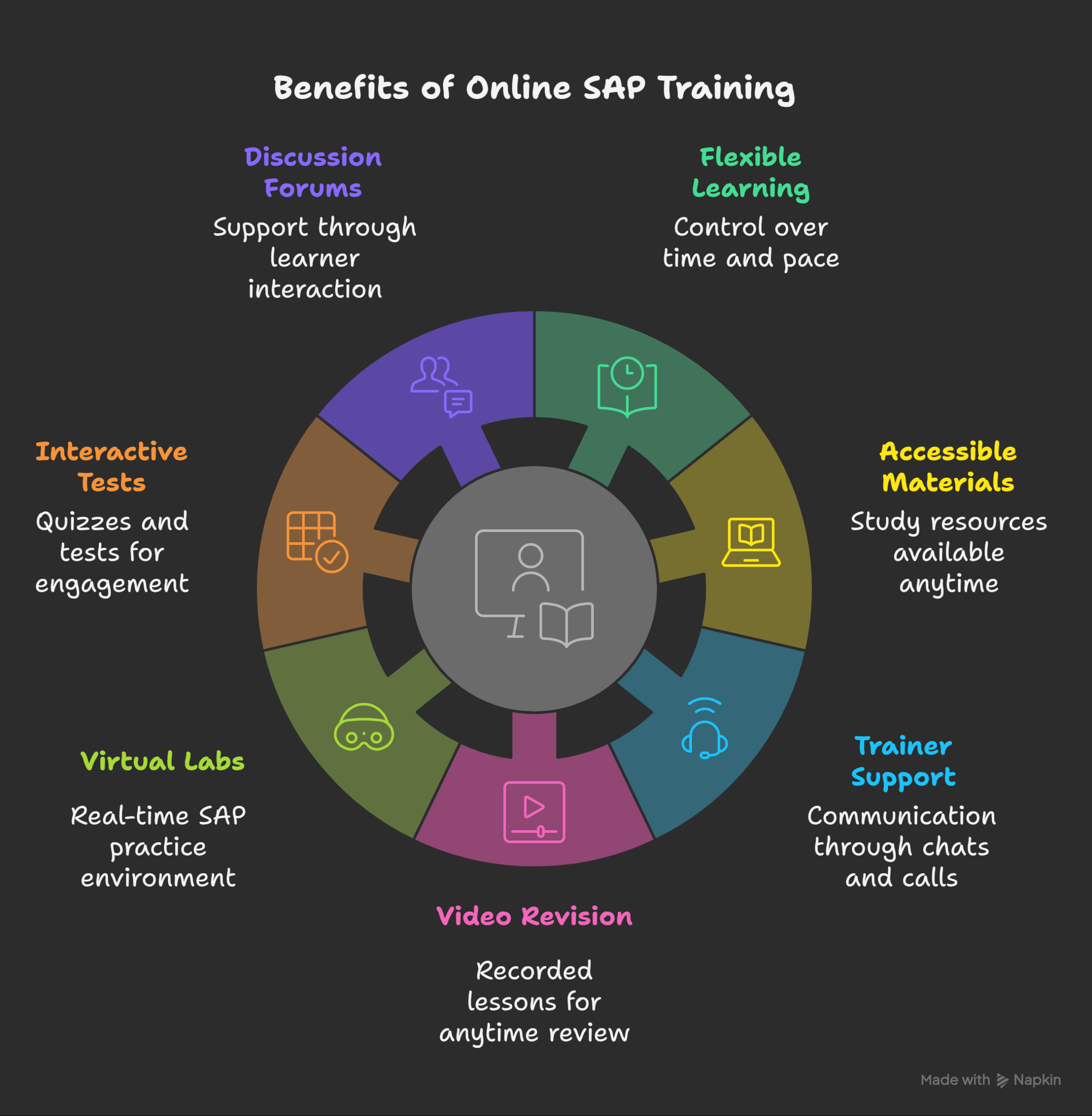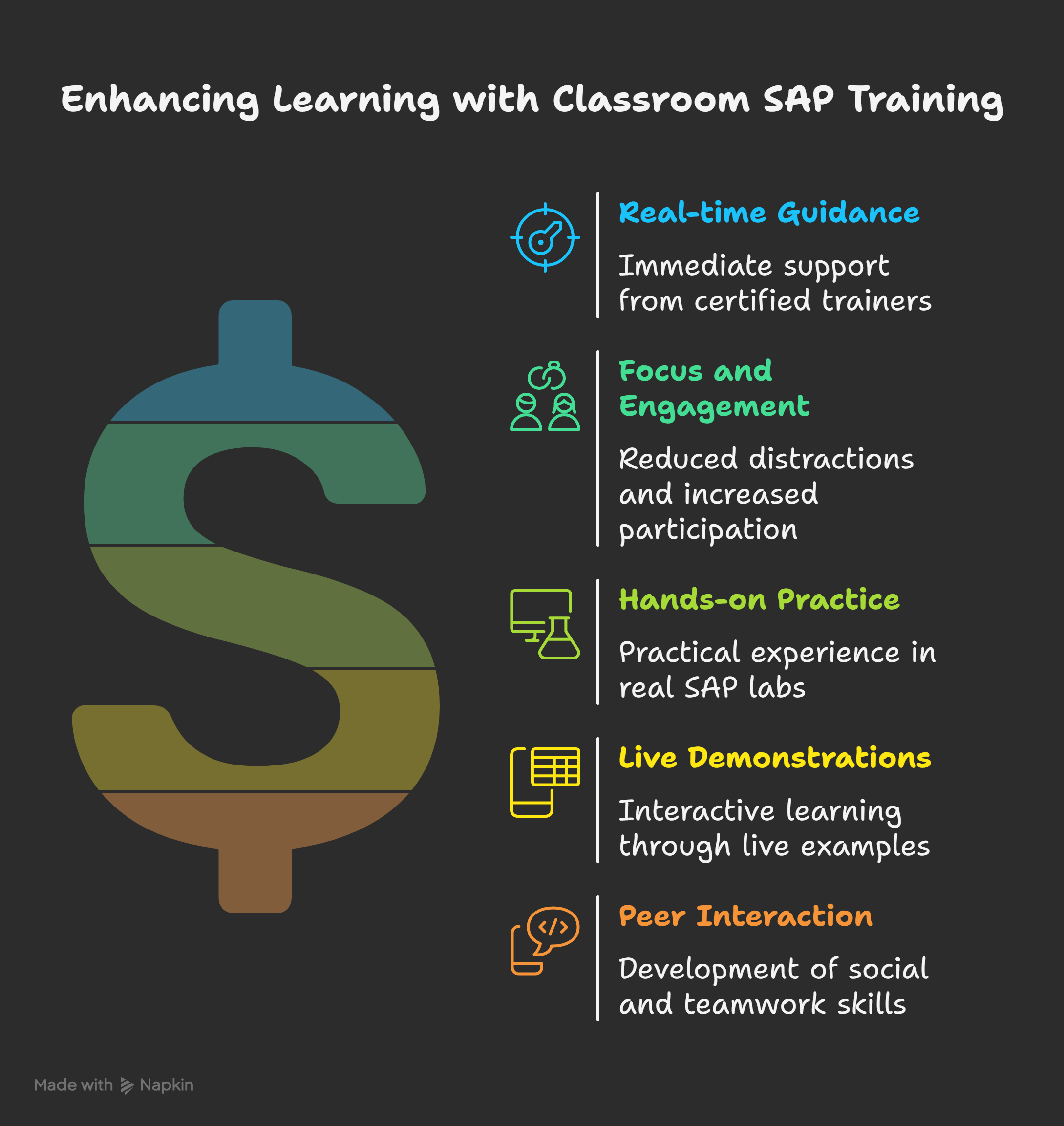Table of Contents
Choosing between SAP Online vs Classroom Training can feel confusing. Both options help you build valuable SAP skills. SAP is used by companies all over the world. Learning it can boost your career fast. But how you learn makes a big difference. Each format has its own unique benefits. Knowing them helps you pick the right one. Let’s understand what suits you best.
SAP training can open doors to great opportunities. Many learners now prefer flexible online options. Others still trust traditional classroom learning. Both paths can lead to success. What matters is your learning comfort and goals. Before you decide, compare them carefully. Here’s a quick look at what affects your choice:
Key Points to Think About:
- Your time and daily schedule
- Learning comfort (online or in-person)
- Budget and training costs
- Access to resources and tools
- Interaction and networking options
- Placement and certification support
Join Entri’s SAP FICO Training Course today!!
1. Introduction
SAP plays a big role in today’s job market. Many global companies depend on SAP systems daily. It helps manage business operations and data effectively. Because of this, SAP professionals are in high demand. Learning SAP can make your career grow faster. Many students and professionals now look for SAP training. But choosing how to learn is very important.
Today, learners can pick SAP Online or Classroom Training. Both offer strong learning experiences in different ways. Online training gives freedom and flexibility to learners. Classroom training offers structure and personal interaction. The right choice depends on your goals and routine. Understanding both formats will help you decide better.
Why this choice matters:
- SAP skills shape your professional growth.
- The right mode helps you learn effectively.
- Flexibility and comfort improve your performance.
- Online or classroom choice affects your results.
- Choosing wisely saves time and money.
- Good training builds strong SAP foundations.
- The right environment boosts confidence and success.
2. Understanding SAP Training Formats
SAP training comes in two main types. You can learn online or in a classroom. Both give strong knowledge but in different ways. Knowing how they work helps you choose better.
2.1 Online Training
Online SAP training is popular among modern learners. It lets you study from anywhere, anytime you want. You can learn using a phone or laptop. The classes fit your schedule and comfort easily. It also supports self-paced and flexible learning styles.
Main Benefits:
- Flexibility: Learn when it suits your routine best.
- Accessibility: Join from home or any location.
- Self-Paced Learning: Move forward at your own speed.
Learning Tools Used:
- Live Sessions: Trainers teach in real-time online.
- Recorded Modules: Watch lessons again for better memory.
- Virtual Labs: Practice tasks in a digital SAP setup.
- Online Doubt Clearing: Ask questions through chats or calls.
Why learners choose online training:
- Busy professionals can manage both work and study.
- Students from remote places can still access lessons.
- Travel time and costs are completely avoided.
2.2 Classroom Training
Classroom SAP training follows a traditional learning style. Learners attend sessions physically with trainers and peers. It gives clear guidance and face-to-face support. The classes run on fixed schedules and time slots. This structure helps students stay focused and disciplined.
Main Benefits:
- Personal Interaction: Directly connect with expert trainers.
- Structured Routine: Fixed class timing builds learning habit.
- Instant Feedback: Get answers right during the session.
Learning Environment Includes:
- Hands-On Practice: Use systems in guided lab sessions.
- Group Work: Solve tasks with classmates together.
- Mentor Support: Trainers guide and correct in real time.
Why learners choose classroom training:
- It encourages teamwork and peer communication.
- Learners feel more engaged during discussions.
- It helps build confidence through live participation.
Comparison: Online vs Classroom SAP Training
| Feature / Aspect | Online Training | Classroom Training |
|---|---|---|
| Location | Learn from anywhere | Attend at a physical center |
| Schedule | Flexible and self-paced | Fixed daily or weekly sessions |
| Interaction | Virtual via video or chat | Face-to-face with trainer and peers |
| Learning Tools | Videos, virtual labs, digital resources | Live labs, group activities, in-person tasks |
| Cost | Usually more affordable | May include travel and extra costs |
| Feedback | Through chat or scheduled sessions | Instant and personal during class |
| Networking | Limited online discussions | Strong peer connections in person |
Both formats offer valuable learning paths for SAP. Your choice depends on your routine and comfort. Once you know these differences, picking gets easier.
3. Key Factors to Consider
Choosing between SAP online and classroom training needs thought. Both options are useful but suit different learners. Your decision should match your routine and comfort. Let’s look at the key factors to compare.
3.1 Learning Style
Everyone learns differently and at their own pace. Some prefer independent learning, others need close guidance.
Online Training:
- Great for self-paced learners.
- Allows review of lessons anytime.
Classroom Training:
- Better for instructor-led learners.
- Offers instant help during lessons.
3.2 Flexibility and Convenience
Flexibility matters, especially for working people or students.
Online Training:
- Study at your preferred time.
- No travel or location limits.
Classroom Training:
- Fixed time and structured routine.
- Ideal for those who prefer discipline.
3.3 Cost
Cost plays a big role in your choice.
Online Training:
- Usually more budget-friendly.
- No travel or stay expenses.
Classroom Training:
- Often more expensive due to setup costs.
- May include travel and material charges.
3.4 Access to Resources
Good resources help you practice and learn effectively.
Online Training:
- Access to recorded videos and e-books.
- Includes virtual labs for practice anytime.
Classroom Training:
- Access to physical labs and trainer tools.
- Real-time demonstrations during lessons.
3.5 Networking Opportunities
Networking can help build career contacts and teamwork.
Online Training:
- Limited to online chats or groups.
- Interaction is mostly virtual.
Classroom Training:
- Offers face-to-face peer discussions.
- Builds stronger team learning connections.
3.6 Placement Assistance and Certification
Both training types offer placement and certifications. Still, support quality varies by training provider.
Online Training:
- Digital certification after course completion.
- Placement support through online portals.
Classroom Training:
- Printed certification and live interview help.
- Direct trainer recommendations are possible.
Comparison Table: Key Factors
| Factor | Online Training | Classroom Training |
|---|---|---|
| Learning Style | Self-paced and independent | Instructor-led and structured |
| Flexibility | Study anytime, anywhere | Fixed time and location |
| Cost | Usually lower and affordable | Higher due to physical setup |
| Resources | Recorded videos, virtual labs | Live demos, hands-on labs |
| Networking | Limited to virtual discussions | Strong in-person peer interaction |
| Certification | Digital certificate provided | Printed certificate provided |
| Placement Support | Online job portals and support | Direct career guidance and referrals |
Each factor helps shape your learning journey. Think about your goals, time, and comfort carefully. Your best choice depends on what fits your lifestyle.
Master SAP with Expert-Led Courses
Unlock your potential with our comprehensive SAP courses! Learn essential modules like SAP MM (Materials Management), SAP SD (Sales and Distribution), and SAP FICO (Financial Accounting and Controlling) from industry experts.
Know More4. Who Should Choose Online SAP Training?
Online SAP training is ideal for flexible learners. It helps people who want comfort and time control. You can learn from home or any quiet place. This mode suits people who manage work and study together. It also helps those living far from training centers. Online training is designed for convenience and balance.
4.1 Best Suited For
Working Professionals:
- Can learn without leaving current jobs.
- Study after work hours or on weekends.
- No need to travel to classes daily.
Remote Learners:
- Perfect for people living in small towns.
- Internet access is enough to start learning.
- Saves travel time and money easily.
Students with Busy Schedules:
- Can plan lessons around other commitments.
- Learn at their own speed comfortably.
Independent Learners:
- Good for self-motivated people.
- Enjoy learning through videos and practice tools.
4.2 Benefits of Online SAP Training
Main Advantages:
- Full control over learning time and pace.
- Study materials are always available online.
- Trainers can be reached through chats or calls.
- Recorded videos help revise lessons anytime.
Extra Features:
- Virtual labs for real-time SAP practice.
- Access to quizzes and interactive tests.
- Discussion forums for learner support.
4.3 Simple Summary Table
| Category | How Online Training Helps |
|---|---|
| Working Professionals | Learn after work, save travel time |
| Remote Learners | Study anywhere with stable internet |
| Busy Students | Choose flexible hours for study |
| Self-Learners | Learn independently at personal pace |
| All Learners | Access 24/7 study materials and support |
Online SAP training gives freedom and comfort to learners. It helps manage time, work, and study with ease. If you like flexibility, this option fits perfectly.
Join Entri’s SAP FICO Training Course today!!
5. Who Should Choose Classroom SAP Training?
Classroom SAP training suits learners who need direct support. It is best for people who enjoy face-to-face learning. This format gives real-time help from expert trainers. It builds discipline through fixed timing and structure. Classroom learning also helps improve teamwork and confidence. Learners stay more engaged through live discussions and tasks.
5.1 Best Suited For
Students Who Prefer In-Person Learning:
- Learn better with classroom interaction.
- Ask questions directly to trainers anytime.
- Get clear, instant answers during lessons.
Professionals Seeking Quick Feedback:
- Trainers give guidance right after each session.
- Helps fix mistakes and improve faster.
- Ideal for skill-based or practical learning.
Learners Who Need Routine:
- Fixed schedules create strong learning habits.
- Easier to focus with daily or weekly classes.
Team-Oriented Learners:
- Enjoy group work and peer discussions.
- Learn faster through shared ideas and teamwork.
5.2 Benefits of Classroom SAP Training
Main Advantages:
- Real-time guidance from certified trainers.
- Strong focus and fewer digital distractions.
- Better engagement through in-person communication.
Extra Features:
- Hands-on practice in real SAP labs.
- Live demonstrations and exercises.
- Peer interaction builds social and teamwork skills.
5.3 Simple Summary Table
| Category | How Classroom Training Helps |
|---|---|
| In-Person Learners | Direct contact with trainers and classmates |
| Professionals | Instant feedback and skill improvement |
| Routine-Focused Learners | Structured timing builds strong discipline |
| Team-Oriented Learners | Encourages teamwork and group discussions |
| All Learners | Builds focus and real-world communication |
Classroom SAP training creates a focused learning space. It helps you learn with discipline and real guidance. If you like structure and interaction, this fits best.
6. Hybrid Approach – Best of Both Worlds
Many learners now prefer a mix of both methods. This mix is called hybrid SAP training. It combines the flexibility of online learning. It also keeps the discipline of classroom sessions. Learners get comfort without losing personal interaction. This approach is now offered by many top institutes. It suits students and professionals equally well.
6.1 What is Hybrid SAP Training?
Hybrid training means learning through both online and offline ways. You can attend live online classes from home easily. Later, you can join workshops or sessions at centers. This model gives balance between flexibility and structure.
How it works:
- Watch recorded videos anytime you need.
- Attend live sessions for real-time help.
- Visit centers for practical workshops occasionally.
- Communicate with trainers online and in person.
6.2 Benefits of the Hybrid Approach
Main Advantages:
- Combines freedom and personal interaction effectively.
- Lets learners manage time with fewer limits.
- Provides full access to digital and live tools.
Extra Features:
- Recorded sessions for easy revision.
- Real-time labs for hands-on practice.
- Flexible schedules with structured learning balance.
6.3 Example: Institutes Offering Hybrid Training
Some learning platforms now use hybrid systems. For example, Entri and similar providers offer:
- Online video modules with trainer support.
- Weekly live sessions for interactive learning.
- In-person workshops for advanced SAP practice.
This setup helps learners gain complete SAP knowledge easily.
6.4 Simple Summary Table
| Feature | Hybrid SAP Training Advantage |
|---|---|
| Flexibility | Learn online and attend offline workshops |
| Trainer Support | Get both live and in-person help |
| Learning Style | Mix of self-paced and structured learning |
| Practice Tools | Access to virtual and real SAP labs |
| Convenience | Study anytime, attend practical sessions nearby |
The hybrid model gives the best of both options. It keeps the comfort of online learning intact. It also adds value through live, real-world sessions. This makes it a perfect choice for most learners.
Conclusion
Choosing the right SAP training mode needs careful thought. Both online and classroom options have great learning value. Online classes give freedom, comfort, and time flexibility. Classroom sessions provide structure, teamwork, and direct support. Your choice should match your lifestyle and learning habits. Every learner is different, so pick what fits best. The goal is to gain strong, practical SAP knowledge.
Whether you choose SAP Online vs Classroom Training, focus on quality. Good trainers and updated materials make a big difference. Always check placement help and certification before joining. Hybrid programs can also give balanced learning benefits. What matters most is steady effort and clear goals. With the right choice, your SAP career can grow. Start learning today and move closer to success.
| Related Links | |
| Which SAP Module Is Best for Freshers in 2025 | Top Companies Using SAP Software in India |
| Which SAP Module is Best for Logistics | Top SAP Interview Questions and Answers (2025) |
Master SAP with Expert-Led Courses
Unlock your potential with our comprehensive SAP courses! Learn essential modules like SAP MM (Materials Management), SAP SD (Sales and Distribution), and SAP FICO (Financial Accounting and Controlling) from industry experts.
Know MoreFrequently Asked Questions
What is SAP training, and why is it important?
SAP training helps learners understand how to use SAP software to manage business processes such as finance, logistics, HR, and supply chain. It teaches both technical and functional aspects of SAP modules. This training is valuable because most large organizations rely on SAP systems for their daily operations. With digital transformation increasing across industries, companies need professionals who can handle SAP efficiently. As a result, SAP-certified individuals often enjoy higher job security and better career growth opportunities.
What are the main differences between SAP Online and Classroom Training?
SAP Online Training offers flexibility and convenience, allowing learners to study anytime and anywhere. It usually includes live sessions, recorded videos, and virtual labs for hands-on practice. Classroom Training, on the other hand, follows a fixed schedule with face-to-face guidance from trainers. It also allows learners to engage directly with peers and instructors, making doubt clearing easier. While online learning is great for busy professionals, classroom learning suits those who prefer structured, interactive environments.
Which format is better for working professionals?
For working professionals, online SAP training is often the better choice. It allows them to balance work and learning without compromising either. Since most online programs provide recorded lectures, learners can revisit lessons whenever needed. Virtual labs also offer hands-on experience similar to classroom setups. Overall, online SAP training gives professionals the flexibility to study at their own pace while continuing their job.
What are the benefits of SAP Classroom Training?
SAP Classroom Training provides direct interaction with expert trainers, which helps learners understand concepts more clearly. The structured environment ensures consistent study habits and discipline. Learners can engage in group discussions, teamwork, and peer learning, which enhance problem-solving skills. Immediate feedback from instructors helps clear doubts quickly. Additionally, the classroom setup builds strong professional networks that can support future career opportunities.
How does SAP Online Training help remote learners?
SAP Online Training is ideal for learners who live in remote or smaller towns without access to physical training centers. It allows them to access quality content and global trainers from anywhere. Most institutes offer virtual labs and cloud-based systems, so learners can practice SAP hands-on. The recorded sessions ensure they never miss any topic, even if they have internet or time constraints. This makes SAP training accessible to everyone, regardless of location.
Are certifications available in both online and classroom training?
Yes, both online and classroom SAP training programs offer certification options. These certifications are recognized by employers and validate your SAP skills. The certification process remains the same, whether you study online or offline. Some institutes even help learners prepare for official SAP certification exams. Always choose a reputed provider that issues credible certificates accepted by companies worldwide.
What should I consider before choosing between SAP Online and Classroom Training?
Before choosing, you should evaluate your daily schedule, learning style, and comfort level with technology. If you prefer flexibility and self-paced study, online training may suit you better. If you enjoy direct interaction and structured schedules, classroom training could be ideal. Cost, location, and availability of trainers also matter. Ultimately, the best choice is the one that fits your goals and lifestyle.
Can I switch from online to classroom training later?
Many training institutes allow learners to switch formats if needed. For example, you can begin online and later attend in-person workshops or practical sessions. Some providers even offer hybrid programs that combine both methods. This flexibility ensures you get the best of both learning experiences. It’s always a good idea to check the policy with your training provider before enrolling.
Does online SAP training provide placement assistance?
Yes, reputed online SAP training providers often include placement support as part of their course. They help with resume building, interview preparation, and job referrals. Many institutes have partnerships with companies looking for SAP professionals. Online learners also get access to digital career portals and mock interviews. With proper guidance and effort, online training can lead to the same job opportunities as classroom programs.
Which learning mode is best for long-term career success?
Both online and classroom SAP training can lead to successful careers if done sincerely. What matters most is consistency, practice, and understanding of core SAP concepts. Online learning gives you flexibility, but it requires discipline. Classroom training gives structure but may require more time commitment. The best choice depends on your learning habits, but with dedication, either mode can help you build a strong and rewarding SAP career.















